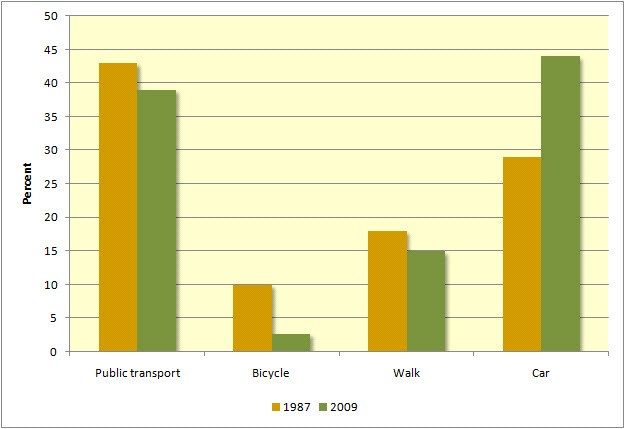
As is often the case in any discussion about cycling in Australia, there are numerous references to “the good old days” when cycling rates were much higher than they are now. The trouble is reliable data on historical cycling levels is hard to find.
I noted recently that only about two to three percent of secondary students cycle to school in Melbourne at present. Thanks to Alan Parker, I now have access to a paper he wrote for the magazine Freewheeling in 1988 summarising a major study of journey-to-school patterns in Melbourne in 1987.
According to Mr Parker’s paper, the study was undertaken by the Ministry of Transport and involved surveying 220,000 students at 420 high schools. They’re very large numbers but unfortunately I don’t have the original study, so I can’t be sure how reliable the data is.
There are many ways the survey could be biased. For example, schools where cycling was actively promoted might have been more diligent in encouraging students to respond. Conversely, some schools with large numbers of cyclists might’ve had uninterested staff and/or students. Accordingly, it’s best to treat the numbers as indicative.
I’ve compared the overall counts by mode with the more recent ones from the VISTA survey (see exhibit – treat these as approximate, as I had to eyeball the ’87 numbers off a graph). What really stands out is the size of the increase in the proportion of high school students who travelled by car.
That increase was at the expense of all other modes, but cycling took the biggest hit. Back in 1987, around 10% of secondary students cycled compared to 2.7% today.
What’s also interesting is more than three times as many boys cycled as girls. I don’t have the split by sex for 2009 but I expect the gaps narrowed appreciably.
The numbers for 1987 are for the journey to school. Many students were driven to school by parents on their way to work in the morning. On the journey home however, the proportion who were driven was much lower (about 16%), while the proportion using public transport exceeded 50%.
I expect there’s a similar asymmetry in the 2009 data too (although I haven’t done that analysis). It’s an important distinction to bear in mind when considering this issue. It’s likely that the higher rates of car ownership and women’s participation in the workforce were key factors driving the increase in morning car use.
Perhaps the most interesting finding is the variability in rates of cycling between schools. Mr Parker only shows differences between municipalities (rather than schools) but there are nevertheless some extraordinarily large divergences.
For example, more than 20% of students attending bayside secondary schools travelled by bicycle. In the old Sandringham municipality the proportion was 48%.
On the other hand, less than 5% of students attending school in inner city and inner suburban municipalities like Footscray, Northcote, Fitzroy, Richmond, Hawthorne and Camberwell cycled to school (Alan Parker has more detail here).
A similar high degree of variability between schools was noted by Smith and Milthorpe in three surveys of cycling conducted in NSW in 1991, 1992 and 1993. They noted some Sydney schools had negligible ridership in all three surveys (pre and post introduction of mandatory helmet law):
Riding is discouraged and even forbidden by some school principals and in other places school location makes cycling particularly hazardous and hence it is probably unattractive to children and discouraged by parents.
There are a number of possible explanations for the variability, including density of schools, availability of public transport, school policies, traffic levels, and so on. Thus it’s not surprising there are large differences in peoples recollections of how much cycling to high school there was back in their day.
This is reinforced by another interesting finding from the 1987 Melbourne survey. Students who attended private secondary schools were much more likely to use public transport and car than State high school students, reflecting their longer average trip distances. Conversely, they were much less likely to cycle or walk.
Whereas circa 38% of State secondary students walked or cycled to school in 1987, the corresponding figure for private secondary students was around 9%. That suggests the increase in private school enrolments over the last 25 years could be a key reason for the decline in non-motorised school travel by students.
The fact that the relatively affluent sand-belt suburbs also displayed the highest levels of cycling in 1987 is consistent with that hypothesis.







Crikey is committed to hosting lively discussions. Help us keep the conversation useful, interesting and welcoming. We aim to publish comments quickly in the interest of promoting robust conversation, but we’re a small team and we deploy filters to protect against legal risk. Occasionally your comment may be held up while we review, but we’re working as fast as we can to keep the conversation rolling.
The Crikey comment section is members-only content. Please subscribe to leave a comment.
The Crikey comment section is members-only content. Please login to leave a comment.